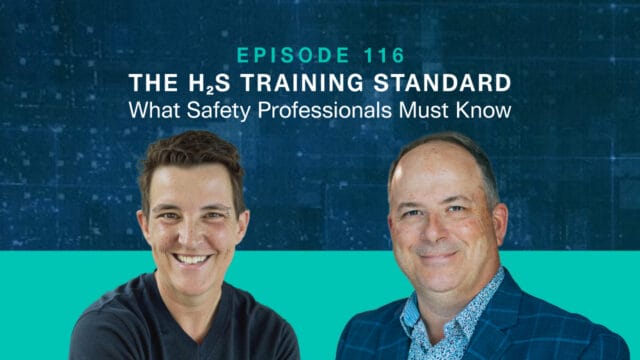
Detecting Impairment, Not History | How Safety Leaders Navigate Legalization | Risk Matrix Episode 117
THE RISK MATRIX Cutting-edge podcast on occupational safety and risk management. Hosted by industry titans: JAMES JUNKIN, MS, CSP, MSP,…
Getting the most out of compliance monitoring software and promoting worker safety requires companies to follow best practices.

Compliance monitoring software has become essential for businesses to ensure worker safety and maintain regulatory compliance on today’s fast-paced and sometimes dangerous job sites. However, to realize these tools’ full potential, companies must do more than install and begin using them–they must also follow a set of best practices.
Best practices enable businesses to enhance safety, eliminate risks, and develop a culture of compliance in the workplace. These procedures range from defining clear objectives to ongoing training and regular updates.
This article discusses seven best practices all safety managers should consider when using safety compliance monitoring tools to create a secure and safe working environment.
Defining compliance objectives is crucial because it provides a clear direction and focus for compliance efforts within an organization.
Businesses can establish specific goals by aligning their efforts with relevant regulations, standards, and internal policies that apply to their industry or operations.
These objectives help companies identify the key areas of compliance that require monitoring and ensure they have configured the compliance monitoring software to address those specific requirements. They also assist companies with the following:
These steps help foster a shared understanding of compliance priorities and promote the right culture throughout the organization. Companies must have well-defined objectives to avoid ambiguity, inconsistent practices, and challenges meeting applicable regulations and standards.
Conducting the appropriate implementation and configuration is essential for successful deployment and use within an organization. This process helps ensure that compliance monitoring tools are:
By investing time and effort in proper integration, companies can optimize the software’s functionality and reliability, leading to enhanced compliance monitoring, streamlined processes, and improved overall compliance management.
Regularly updating and maintaining compliance monitoring software helps ensure its effectiveness and reliability over time. Software updates often include the following steps:
By keeping these tools up to date, companies can mitigate potential risks and ensure the security of sensitive compliance data. These regular maintenance activities that help maintain the software’s optimal performance should include the following:
Ongoing monitoring and maintenance also allow businesses to promptly identify and address any issues or inefficiencies, ensuring that the software meets compliance requirements and supports effective compliance management.
By staying current with updates and diligently maintaining the tools, companies can proactively protect against emerging threats and maintain the reliability and longevity of their compliance monitoring efforts.
Security measures help protect sensitive data and ensure the integrity of compliance processes. Compliance data often includes documentation the company must safeguard from unauthorized access or breaches, including the following:
Implementing security measures such as data encryption, access controls, and user authentication helps prevent unauthorized access to the software and the data it manages. Regular monitoring and auditing of user access and activities within the software enable organizations to detect and respond to any potential security incidents promptly.
Lastly, by prioritizing security, companies can instill trust among stakeholders, including employees, customers, and regulatory bodies, that they handle compliance data with the highest level of confidentiality and protection.
Training and education are crucial for maximizing the software’s effectiveness and ensuring employees use it successfully when completing compliance-related tasks.
More specifically, training allows employees to understand the following aspects of the software better:
Similarly, ongoing policy and procedure education can offer companies with the following benefits:
By investing in training and education, organizations can maximize the return on investment in compliance monitoring software and foster a knowledgeable and skilled workforce that actively contributes to maintaining compliance standards.
Monitoring and analyzing safety compliance data is vital for adequately maintaining safety monitoring software. By doing so, organizations can identify the following:
Understanding these data points allows for timely interventions and corrective actions to mitigate hazards, prevent accidents, and benchmark their safety performance against industry standards to promote a culture of continuous improvement.
Software audits and assessments help companies maintain and improve organizational safety standards. They systematically and objectively evaluate safety management systems, processes, and practices.
More specifically, companies can accomplish the following by conducting audits:
Ultimately, conducting periodic safety audits and assessments promotes a proactive safety culture, mitigates risks, and ensures the well-being of employees while reinforcing compliance with safety regulations and industry best practices.
Adopting and implementing best practices for compliance monitoring software is essential for companies to maintain a safe and compliant work environment. The abovementioned best practices enhance safety and mitigate risks, contribute to a positive safety culture, and promote continuous improvement.
With a well-implemented and well-utilized solution, businesses can confidently navigate the complexities of regulatory compliance, protect their employees, and build a strong foundation for long-term success.


THE RISK MATRIX Cutting-edge podcast on occupational safety and risk management. Hosted by industry titans: JAMES JUNKIN, MS, CSP, MSP,…

THE RISK MATRIX Cutting-edge podcast on occupational safety and risk management. Hosted by industry titans: JAMES JUNKIN, MS, CSP, MSP,…
We’ll send you practical and insightful supply chain risk management info that can benefit your business. Plus, important company updates that keep you in the loop.
